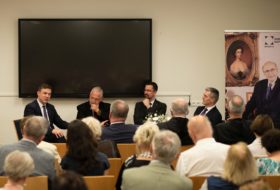During the visit, we met and talked with Tamás Dénesi, the Director of the Archabbey Archives and with Cultural Director Father Konrád Dejcsics, with whom we reviewed the sources related to the above topic.
Through the visit, it became clear that a unique, hitherto unexplored archival and photographic material was available about the relationship between the young Otto von Habsburg and the Benedictines in Hungary. Otto was prepared for his 1930 Hungarian-language graduation by such scholarly monks of the 19th century as Jákó Blazovich, Jób Bánhegyi and Róbert Vlasits. Their personal correspondence provides insight into the every-day life of the royal family after the death of Charles IV. Examining the archival material, it turned out that the here guarded legacy of Elemér Lónyay and his wife, – Princess Stefánia, the widow of Crown Prince Rudolf – also contains unique information and images about the life history of Otto von Habsburg.
Based on what we have seen, we have compiled a professional cooperation program for the next year. Our goal is to make the extremely valuable source material preserved in Pannonhalma – which can provide interesting and even fun minutes for the wider public – a public treasure in a worthy form.
Szilveszter Dékány
Gergely Fejérdy
Gergely Prőhle


